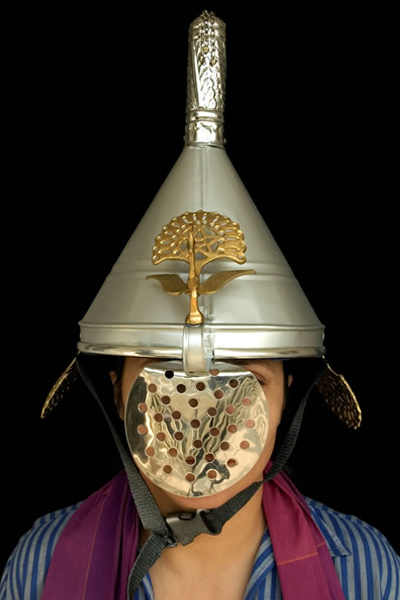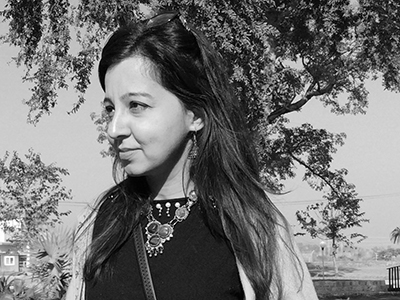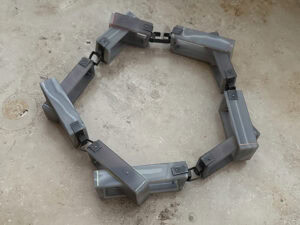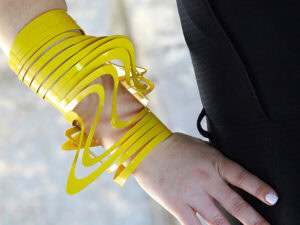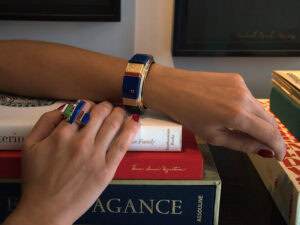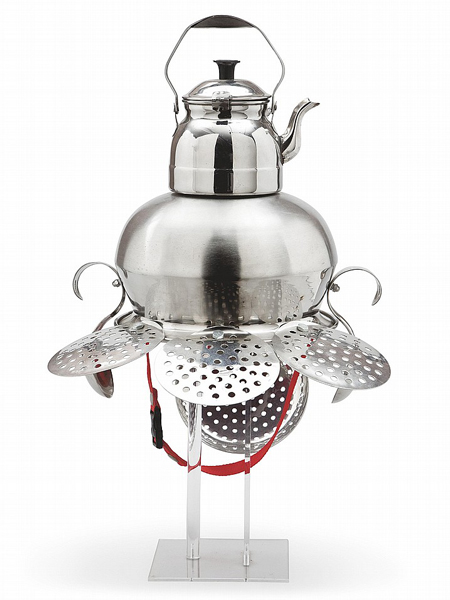
Found objects can be both vague and mundane yet offer immeasurable meanings thanks to their utilitarian aspect and their position within a nebula of historical and social values. Once appropriated in contemporary artistic process, the formal language of found objects finds new coordinates in the aesthetic space of the found and the maker.
Adeela Suleman’s Stainless Steel Helmet with Kettle is an accumulation of found kitchen objects, deformed and reconstructed, which references three distinct sociocultural environments. The “found objects” themselves all come from the kitchen, and point to a variety of female-associated domestic activities, and to a wider context of amateur applied craft. Meanwhile, a closer read of the ornate edge of the tea sieve points to the jewels of the Mughals and Raj rulers of the Indian subcontinent: they were known to mount wrought-gold heron feathers or mango motif ornaments called sarpech in the centers of their turbans to symbolize their elevated power and dignity. Finally, the headgear apes the language of steel motorbike helmets usually worn by men in Pakistan.
One of the keys to understanding Suleman’s piece comes from the form itself: drainers, sieves, kettle, cooking pot, and ladles with their handles extended out in symmetrical ornate curvatures are activated as both “protective helmet” and “extended body ornament.” The ornament’s formal hierarchy is symbolic of Raj stepped and brocaded crowns which the rulers in the subcontinent commissioned from Cartier during British rule. But this piece, when worn and photographed, highlights the wearer’s vulnerability and the unfolding identity crisis of the artist. It activates the artist’s self—at once alienated and protected—as other, inextricably embedded in patriarchal notions of womanhood. Where some of her later installations and body ornaments appear more organic, this piece invites constraint and rigidness. It beautifies yet cages a female’s head.
As in most of her pieces and installations, the punctured holes, curves of handles, and pear-shaped leitmotif in the center elicit a sense of geometry and rhythm. But upon closer inspection, the forms reveal tensions between ideas of ornamentation and the cultural signifiers this object references. By using the same elements repetitively, Suleman’s piece finds agency in a new role: one that is not masculine or feminine, is neither protective gear nor an elaborate ornament, but a form of public gadget that transcends these very boundaries. Through this new existential dimension, Suleman investigates traditional gender spaces and how instant readings of cultural motifs like feather, tea sieve, and helmet offer ambivalence in meanings and visual perceptions.
A powerful conflict is at work here: Through the dynamics of kitchen and social norms, Suleman endows everyday utensils with a latent energy that negates the self while constituting an act of resistance and liberation. Meaning is sought at the intersection of private and public spheres, in the perpetual gap between the two dissonant patterns.
